
Choosing the right dog breed for a family with children is one of the most important decisions parents can make. The right canine companion can not only enhance family life but also teach children valuable lessons about responsibility, empathy, and compassion. Conversely, the wrong choice can lead to frustration, anxiety, and behavioral issues for both the dog and the children. As families grow, so do their needs, and understanding the ideal dog breeds for families with kids is essential for fostering a harmonious household. This article will explore the five best dog breeds for families with children, emphasizing their characteristics, temperament, and energy levels.
By the end of this comprehensive guide, you will be equipped with all the necessary information to make an informed decision that not only suits your family’s lifestyle but also enriches the lives of your children and your future furry friend.
The Importance of Choosing the Right Breed
When considering adding a dog to your family, the importance of selecting the right breed cannot be overstated. A well-suited dog can significantly contribute to family dynamics and the overall well-being of children. Here are some key reasons why choosing the right dog breed is essential:
- Compatibility: Different dog breeds exhibit varying temperaments, energy levels, and play styles. Some breeds thrive in active environments, while others prefer calm settings. It’s crucial to understand which breeds are generally more compatible with children to avoid potential conflicts.
- Safety: Safety is a significant concern when it comes to children and pets. Some dog breeds are more tolerant of rough play and unpredictable behavior, which is common in young children. A dog that is gentle and patient can prevent accidents and promote a positive relationship between kids and pets.
- Long-Term Commitment: Dogs are a long-term commitment, often living for 10 to 15 years or more. Understanding the specific needs and characteristics of various breeds can help you choose a dog that aligns with your family’s lifestyle and dynamics.
- Creating Lasting Bonds: A well-matched dog can become a lifelong companion for your children, teaching them essential life skills and values such as responsibility, empathy, and compassion. This bond can significantly enrich your child’s upbringing and overall emotional development.
- Developmental Benefits: Studies have shown that children who grow up with pets experience numerous developmental benefits, including improved social skills, emotional regulation, and a reduced risk of anxiety and depression.
In this article, we will highlight the top five dog breeds that are well-suited for families with kids, analyzing each breed based on temperament, energy level, and compatibility with children.
The Top 5 Dog Breeds for Families with Kids
1. Labrador Retriever
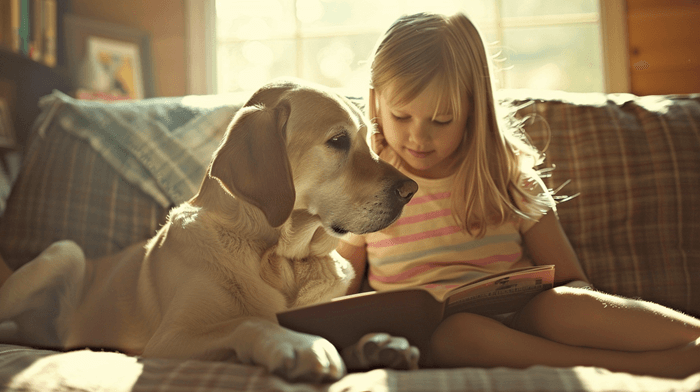
Temperament: Friendly, outgoing, and eager to please.
Energy Level: High.
Labrador Retrievers are one of the most popular dog breeds in the world and for good reason. Their friendly and outgoing nature makes them an excellent choice for families with children. Labradors are known for their playful, affectionate demeanor, and they generally get along well with kids of all ages.
- Personality Traits: Labradors are sociable and enjoy being part of family activities. They thrive on interaction and are highly trainable, making them a great fit for families looking for an engaging companion.
- Exercise Requirements: Labradors have high energy levels and require regular exercise. Daily walks, playtime in the yard, or trips to the dog park are essential to keep them physically and mentally stimulated. This can also be a wonderful opportunity for family bonding.
- Health Considerations: While Labradors are generally healthy, they are prone to certain conditions such as hip dysplasia and obesity. Regular vet check-ups and a balanced diet are crucial for maintaining their health.
Benefits:
- Great Temperament: Labradors are known for their friendly demeanor and patience, making them wonderful companions for kids. They are less likely to exhibit aggression and are known for their gentle nature.
- Active Lifestyle: Their high energy level means they enjoy playing fetch or going for runs, encouraging a healthy lifestyle for the whole family.
- Intelligent: Labradors are highly trainable, which can make obedience training easier and more enjoyable for children. They excel in various dog sports and activities, further strengthening the bond between the dog and the family.
2. Golden Retriever

Temperament: Intelligent, friendly, and devoted.
Energy Level: Moderate to high.
Golden Retrievers are another breed that stands out as ideal for families. They are well-known for their gentle and friendly nature, making them particularly good with children. Their intelligence and eagerness to please make training relatively straightforward, and they thrive on positive reinforcement.
- Personality Traits: Goldens are incredibly loyal and form strong attachments to their families. They are typically very social dogs and enjoy being around people, making them great companions for children.
- Exercise Requirements: Golden Retrievers have moderate to high energy levels and require regular exercise. They enjoy outdoor activities such as running, swimming, and playing fetch. Engaging in physical activities together can enhance family bonds.
- Health Considerations: Golden Retrievers are susceptible to certain health issues, including hip dysplasia, elbow dysplasia, and certain types of cancer. Regular vet visits and a healthy diet can help mitigate these risks.
Benefits:
- Gentle Nature: Golden Retrievers are known for their gentle and loving disposition, which helps create a nurturing environment for children.
- Versatile: They adapt well to various activities, from hiking to swimming, allowing families to enjoy diverse outdoor experiences. This versatility makes them a fantastic choice for active families.
- Social Dogs: Their friendly nature makes them excellent companions not just for children but also for other pets and family members. Goldens tend to have a calming effect on children, helping to create a harmonious household.
3. Beagle
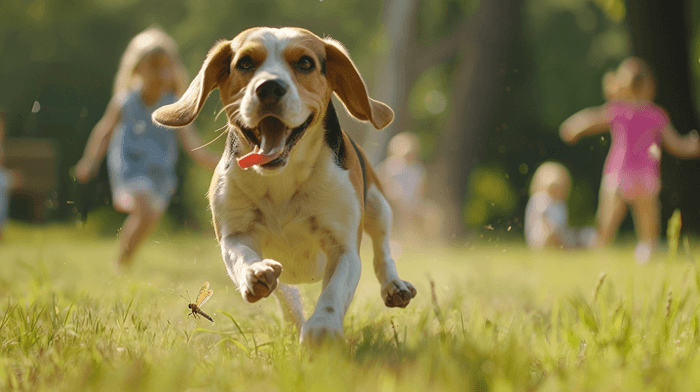
Temperament: Curious, friendly, and merry.
Energy Level: Moderate.
Beagles are small to medium-sized dogs that are friendly and curious, making them excellent companions for children. Their playful nature and love for exploration can keep kids entertained for hours.
- Personality Traits: Beagles are known for their joyful and lively spirit. They are intelligent and require mental stimulation to keep them engaged. Their friendly demeanor makes them great playmates for children.
- Exercise Requirements: Beagles have moderate energy levels and require regular exercise. Daily walks and playtime are essential for their well-being. They thrive on activities that engage their sense of smell, so scent-based games can be particularly enjoyable for them.
- Health Considerations: Beagles are generally healthy but can be prone to certain conditions such as obesity and ear infections. Regular vet check-ups and a healthy diet are important for maintaining their health.
Benefits:
- Playful and Fun: Beagles are energetic and love to play, making them great for active families. Their natural curiosity can lead to fun adventures for kids.
- Small Size: Their size makes them a manageable option for families with limited space, making them suitable for both apartments and houses.
- Friendly Disposition: Beagles are generally good with kids and other pets, making them a wonderful addition to family life. Their sociable nature helps them adapt to various family dynamics.
4. Bulldog
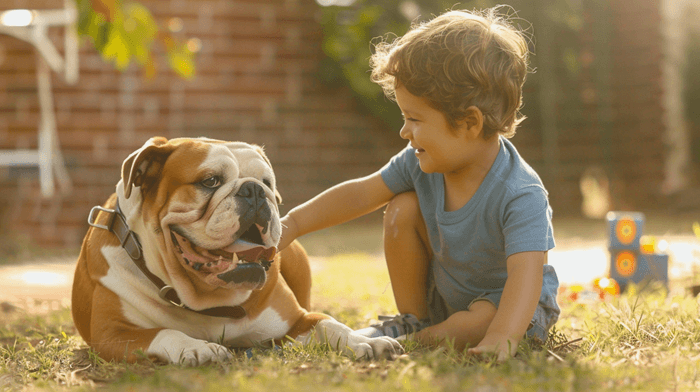
Temperament: Docile, friendly, and courageous.
Energy Level: Low to moderate.
Bulldogs have a unique charm with their distinctive appearance and calm demeanor. They are great with children and can adapt well to a family environment, making them a solid choice for families who prefer a more laid-back dog.
- Personality Traits: Bulldogs are known for their gentle and affectionate nature. They are loyal and protective of their families, making them ideal companions for children.
- Exercise Requirements: Bulldogs require less exercise than many other breeds. Short walks and playtime in the yard are usually sufficient to keep them happy. This makes them suitable for families with a more sedentary lifestyle.
- Health Considerations: Bulldogs are prone to certain health issues, such as breathing problems and skin conditions. Regular vet check-ups are crucial for monitoring their health.
Benefits:
- Gentle Giants: Bulldogs are known for their loving and gentle nature, making them wonderful companions for children. They often exhibit a calm demeanor, which can be soothing for kids.
- Low Exercise Needs: They require less exercise than many other breeds, making them suitable for families with a more sedentary lifestyle. This allows for flexibility in daily routines.
- Loyalty: Bulldogs are known for their loyalty and protective nature, providing a sense of security for the family. Their affectionate behavior often helps strengthen the bond between children and their pets.
5. Poodle
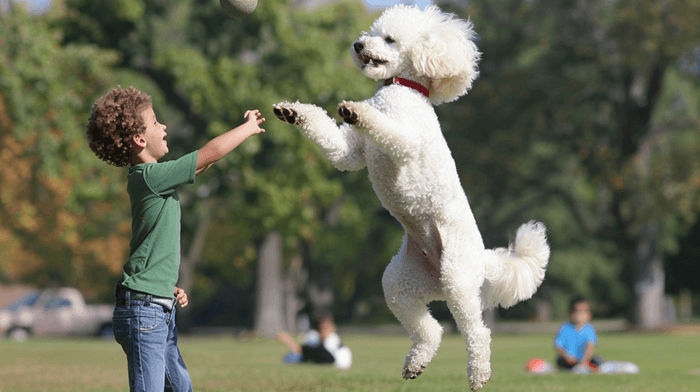
Temperament: Intelligent, active, and alert.
Energy Level: High.
Poodles are incredibly versatile dogs that come in various sizes (standard, miniature, and toy). They are highly intelligent and easily trainable, making them a great fit for families looking for a dog that can learn quickly and engage with kids.
- Personality Traits: Poodles are known for their elegance and playful nature. They are friendly and social, making them great companions for children. Their intelligence allows them to pick up commands and tricks quickly.
- Exercise Requirements: Poodles enjoy physical activity and need regular exercise to stay happy and healthy. They excel in dog sports and require mental stimulation to prevent boredom.
- Health Considerations: Poodles are generally healthy but can be prone to certain genetic conditions. Regular vet visits and a balanced diet can help mitigate these risks.
Benefits:
- Highly Trainable: Poodles are among the most intelligent dog breeds, making them easy to train for various tasks and tricks. This quality is especially beneficial for families wanting to teach their children how to train a dog.
- Active Lifestyle: Their high energy levels mean they enjoy engaging activities, encouraging families to stay active together. This promotes a healthy lifestyle for both kids and pets.
- Hypoallergenic Option: Poodles have a unique coat that minimizes shedding, making them a great choice for families with allergies. Their coat requires regular grooming, which can also be a fun activity for children to participate in.
Benefits of Choosing the Right Dog Breed
Choosing the right dog breed can bring numerous advantages to your family life. Here are five key benefits of selecting a dog that is well-suited for families with children:
1. Enhanced Family Dynamics
Having a dog can significantly enhance family dynamics. Dogs provide companionship and love, creating a sense of unity within the family. Children can develop a sense of responsibility by helping care for the dog, from feeding and walking to grooming and training.
2. Emotional Support
Dogs offer unconditional love and companionship, which can be especially beneficial for children. Research shows that pets can help reduce feelings of loneliness and anxiety in children, providing them with emotional support during challenging times.
3. Promoting Physical Activity
Dogs require regular exercise, encouraging families to be more active together. Walking, playing fetch, and participating in outdoor activities can help children develop a love for fitness and outdoor exploration.
4. Social Skills Development
Growing up with a dog can enhance children’s social skills. Interacting with pets can improve communication and empathy, teaching kids how to express their feelings and understand the emotions of others.
5. Responsibility and Routine
Caring for a dog involves a consistent routine, which can help teach children about responsibility. Feeding, grooming, and walking the dog require commitment and can instill a sense of accountability in children.
Practical Tips for Integrating a Dog into Your Family Life
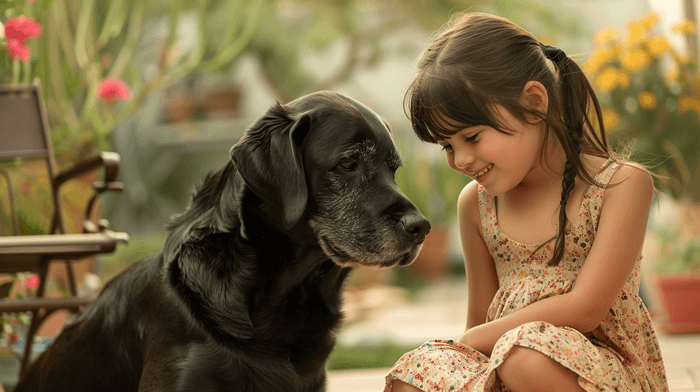
Adding a dog to your family can be an exciting adventure, but it also requires careful planning and consideration. Here’s a step-by-step guide to help you integrate a dog into your family life successfully:
Step 1: Research Breeds
Begin by researching various dog breeds to identify which ones align with your family’s lifestyle. Consider factors such as energy level, temperament, and grooming needs. Look for breeds known for their compatibility with children.
Step 2: Assess Your Home Environment
Evaluate your living space to determine whether it can accommodate a dog. Consider the size of your home, yard space, and whether you have children who can help care for the dog.
Step 3: Prepare Your Family
Before bringing a dog home, prepare your family for the responsibility. Discuss the roles and responsibilities each family member will have in caring for the dog. This includes feeding, walking, and training.
Step 4: Choose the Right Dog
Once you’ve done your research and prepared your family, visit local shelters, rescues, or breeders to find the right dog for your family. Spend time with potential dogs to assess their temperament and how they interact with your children.
Step 5: Introduce the Dog to Your Home
When you bring your new dog home, introduce them to their new environment gradually. Allow them to explore and get comfortable in their new space. Supervise interactions between your dog and children to ensure a positive experience.
Step 6: Establish Routines
Establish daily routines for feeding, exercise, and training. Consistency is key to helping your dog acclimate to their new home. Encourage your children to participate in these routines to foster a sense of responsibility.
Step 7: Training and Socialization
Invest time in training your dog. Basic obedience commands can help establish good behavior and strengthen the bond between your dog and family. Enroll in training classes if necessary and expose your dog to various social situations to ensure they are well-adjusted.
Step 8: Monitor Interactions
Always supervise interactions between your dog and children, especially during the initial adjustment period. Teach your children how to interact gently with the dog and respect its space.
Common Mistakes to Avoid When Choosing a Dog
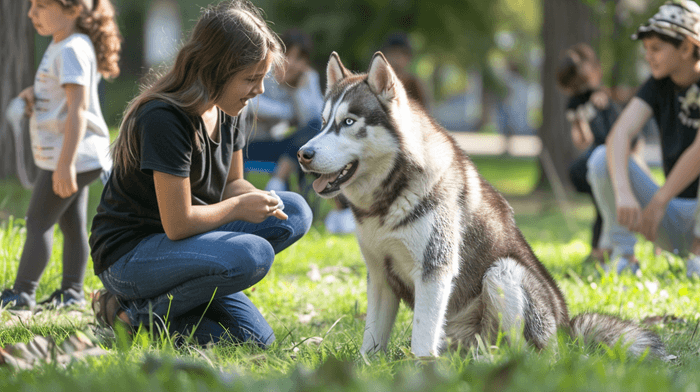
Choosing the right dog breed for your family can be challenging, and there are several common mistakes that many families make. Here are some pitfalls to avoid:
1. Ignoring Breed Characteristics
One of the most common mistakes is ignoring the specific characteristics of a breed. Each breed has its unique traits, energy levels, and temperaments. Failing to research these can lead to an incompatible match.
2. Underestimating Time Commitment
Bringing a dog into your family is a long-term commitment. Many families underestimate the time required for training, exercise, and care. Be prepared to dedicate time to your new pet.
3. Not Considering Family Lifestyle
It’s essential to consider your family’s lifestyle when choosing a dog. Families with active lifestyles may benefit from high-energy breeds, while those who prefer a more laid-back approach may want to consider calmer breeds.
4. Skipping Socialization
Failing to socialize your dog can lead to behavioral issues. Early exposure to various environments, people, and other animals is crucial for a well-adjusted pet.
5. Neglecting Training
Proper training is vital for any dog, especially when children are involved. Neglecting training can lead to behavioral problems that could affect the safety and harmony of your household.
Scientific Backing for Choosing the Right Dog
Several studies highlight the importance of selecting the right dog breed for families with children. Research conducted by the American Veterinary Medical Association (AVMA) emphasizes the benefits of dog ownership, including the development of social skills and emotional support for children.
A study published in the Journal of Pediatric Psychology found that children who grow up with pets demonstrate improved social skills and emotional regulation. Additionally, the presence of a dog can enhance family bonding, leading to stronger familial relationships.
According to the Centers for Disease Control and Prevention (CDC), having pets can also contribute to physical activity, promoting a healthier lifestyle for families. Engaging in activities such as walking or playing fetch with a dog can encourage families to be more active together.
Conclusion

Choosing the right dog breed for your family is a crucial decision that can profoundly impact your household dynamics and your children’s development. By selecting a breed that aligns with your family’s lifestyle and values, you can create a loving and nurturing environment for both your children and your furry friend.
As you embark on this exciting journey of adding a dog to your family, remember the importance of research, preparation, and commitment. Embrace the joys and challenges of dog ownership, and watch as your new companion enriches your family life.
For those looking to deepen their understanding of dog training and care, consider investing in the “Dog Trainer Bible.” This comprehensive guide provides valuable insights into effective training techniques and tips for creating a harmonious relationship with your dog.
